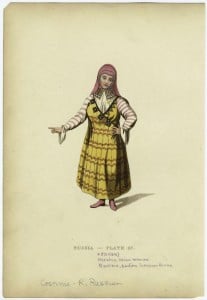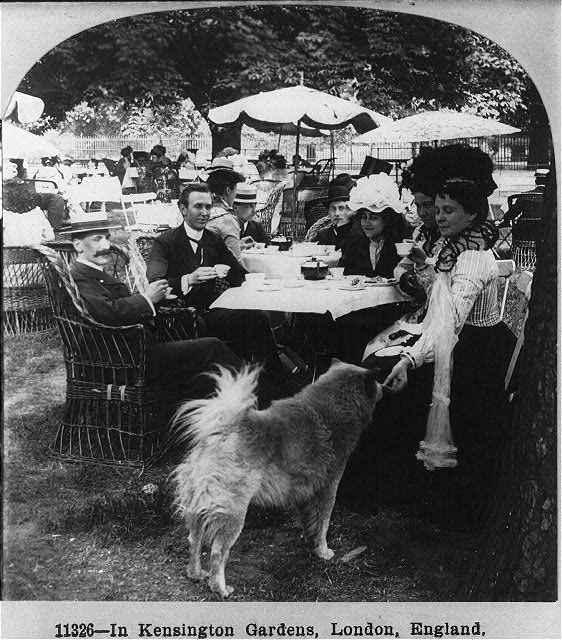Blog Archive
They Walk Among Us: Vampire and Immigration in Victorian London

Dark and rainy by nature, London was just waiting for its moment in the Gothic low-light. Photo courtesy of the Library of Congress.
They’re here. Vampires are with us in our daily lives. The time when they seemed to appear only around Halloween is past- if it ever existed. With the popularity of Anne Rice’s book series, then Stephenie Meyer’s (perhaps you have heard of Twilight), young women of all ages have fallen in love with this particular avatar of the undead. A million spin-offs later it may be hard to trace when all these beings began to haunt us.

Bats: considered a threat to the blood stream and women's hair since at least 1897. Photo courtesy of the New York Public Library.
Vampires have existed in the human imagination in some form for hundreds of years, but the first famous vampire came in with immigrants to Victorian London. Some argue that Dracula, the monster Bram Stoker created his in 1896 novel, is a response to the waves of eastern European immigration which were flooding England in the final decades of the 19th century.
Those who have studied Stoker’s original text detect clues to suggest that in many cases this villain stands in for the threatening masses of eastern European immigrants, many of them Jews, who migrated to London.
By now, most of us are familiar with this vampire story: an undead figure from Transylvania is enticed to London where he stalks two women. Spoiler alert! One who succumbs to him and one who resists. Eventually, with the help of clear heads and cool consciousness (as in most British narratives) the evil is vanquished.

The real threat: a portrait of a woman in traditional dress from Bashkir Russia in 1814. Photo courtesy of the New York Public Library.
The novel presents continuous contrasts between the folklore of Eastern Europe and the moral decency and scientific uprightness of modern London. That fact that Dracula is able to move unimpeded through London spoke to the terror of a hybrid city. The idea of contaminated blood can be seen partly as a fear of miscegenation, or a ‘contamination’ of the British population.
Women were especially idealized during the Victorian era, the period which was just ending as Dracula was written. The Victorian woman was supposed to be selflessly devoted to the home and the family. It is the more independent of the two female characters who falls prey to Dracula. There is a sexual element to the way Dracula preys on women, and therefore also a moral warning against the more liberated woman who was emerging at the end of the Victorian era. The warning inherent in the sexual element of Dracula’s predation is less a direct accusation against immigrants than just a general call for “things as they were.” (Curiously, the most famous vampire of the 21st century, Edward Cullen from the Twilight series is characterized as sexually abstinent- different approach, same moral message.)

Feeding the beast in Kensington Gardens, London. These proper British citizens are all behaving respectably...for now. Photo courtesy of the Library of Congress.
Dracula is said to be in some ways inspired also by the Jack the Ripper cases in 1888. In these cases a serial killer is believed to have killed and mutilated at least five prostitutes in the neighborhoods around Whitechapel in London. These neighborhoods, which were poor and predominately Jewish, became the focus of intense speculation and xenophobia. The insularity of the Jewish ‘ghettos’ was blamed for the difficulty the police had in solving the murders. The murders were deemed the work of a Jewish killer, around whom the community ‘closed ranks.’ The Chicksand neighborhood in Whitechapel is the setting of much of the action in Dracula as is Bermondsey, a town similarly settled by immigrants.
As further evidence of this theory: Stoker’s characters also refer to the Hungarian social critic Max Norda, whose work “Degeneration,” which focuses on the moral degeneration of Eastern Europe, had just been published in English.
Ghost stories and superstitions are often conjured by a community to answer to some threat and serve as a warning or fable terrifying children and titillating adults. As vampires continue to haunt popular culture remember they could be representing more earthly concerns than just the Prince of Darkness.

Merchandise from the outstandingly popular book and movie series, Twilight, featuring a chivalrous, abstinent vampire: now in lunchrooms everywhere. Photo courtesy of Amazon.
–Posted by Julia Berick
With a great debt and special thanks to Greg Buzwell of the British Library whose article “Dracula: vampires, perversity and Victorian anxieties” was a fascinating resource.